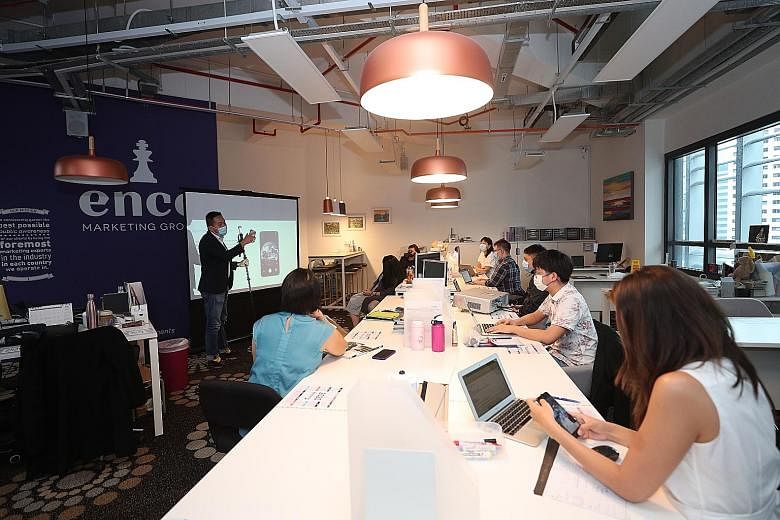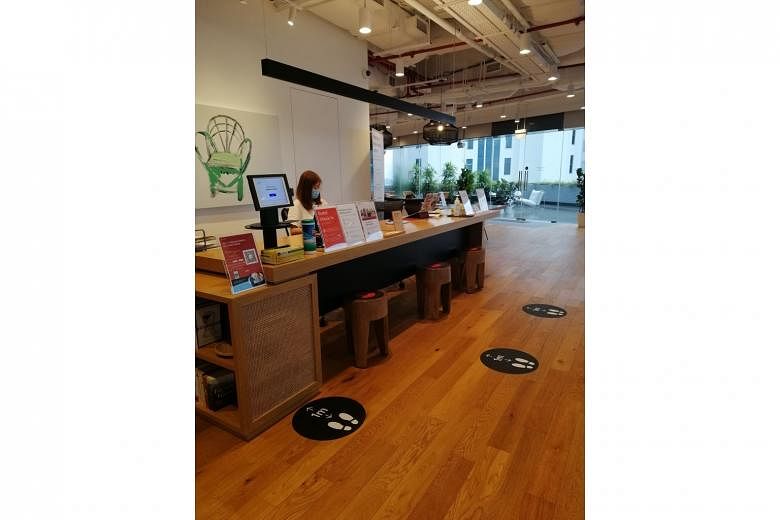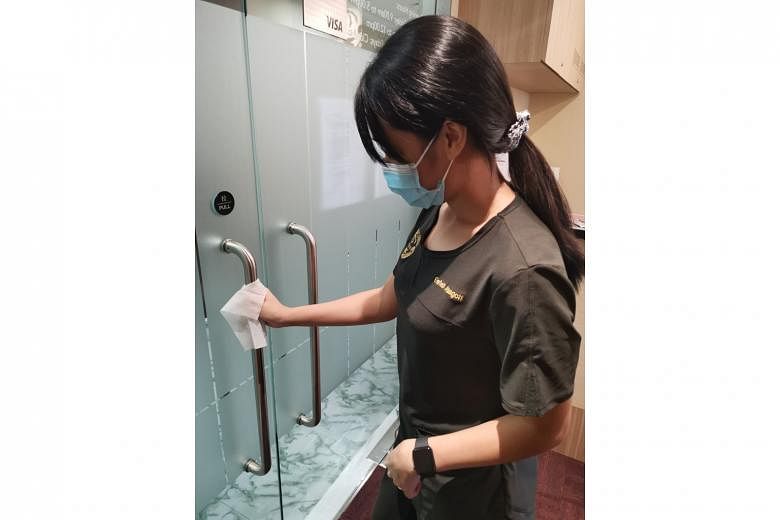It is Wednesday in the headquarters of Ence Marketing Group in Raffles Place, and a course on using a 360-degree camera is in session.
But instead of conducting the training in a small, 108 sq ft conference room, the staff are seated at their desks in its 1,000 sq ft main office area for social distancing.
While they fiddle with the contraption, the presenters' slides are projected onto a large screen.
This might be the office of the future, a more regulated one where colleagues sit farther apart, with masks on, and with many other employees working from home.
As part of safe-management measures for businesses, employers here must ensure that employees who have been working from home continue to do so.
Employees should return to the office only when it is demonstrably necessary, such as to access specialised terminals or dedicated machines, or complete a contract or transaction that is legally required to be done in person and on-site.
Globally, more people are working remotely, resulting in smaller offices and fewer workers in them. Technology firm Fujitsu recently announced a permanent work-from-home plan, and said it will cut its office space in Japan by half over the next three years.
Since the outbreak, many firms in Singapore have also seen the emergence of a company culture which is less office-centric.
Ms Angela Sim, 44, managing director of Ence Marketing Group, which has offices in the region, says that pre-Covid-19, it had already invested in infrastructure and software to allow staff to work remotely. But it did not implement a full work-from-home arrangement for its staff here, as they preferred going to the office and interacting with colleagues.
"When Covid-19 happened, we had no choice. We now go to the office only when we have to use certain specialised equipment."
Even then, many safety measures have to be followed. Before entering the office, staff need to have their temperature taken and check-in via SafeEntry. Work stations have to be more spread out, with only four staff at a table, instead of six previously.
More stringent hygiene practices at the workplace are now also the norm.
For example, when the International Centre for Thoracic Surgery, a clinic at Mount Elizabeth Novena Specialist Centre, reopened on June 15, it placed hand soap and hand sanitiser at every sink in the clinic.
After each patient leaves, a clinic assistant wipes down the common area, door handles and sofa. Only one staff member can be at the registration counter at any time and staff cannot congregate in the pantry.
At WeWork, which operates 12 co-working spaces in Singapore, vinyl floor decals and wall signs displaying the expected 1m safe distancing can be found in the hallways and community areas.
Many firms have also leveraged on technology in a bigger way since the outbreak.
At digital consultancy firm 2359 Media, chatbots are becoming an integral part of the office. Since April, its office landline has been answered by a voice chatbot capable of asking callers what they need, providing simple solutions or redirecting them to the relevant department.
If the chatbot does not have an answer, it takes down a message and staff will return the call.
Since early February, the company has also been using a chatbot which logs employees' daily temperature, health status and whether they visited the office that day.
While experts expect workplaces to become smaller in the future, law firm PKWA Law Practice is bucking the trend for now. Its office at the HDB Hub building in Toa Payoh expanded in May, when it took over an adjacent office unit so its desks could be more spaced out.
Mr Lim Chong Boon, a director at the firm, says the move was to ensure a safe working environment for its more than 100 employees. But looking ahead, he believes there will be less of a need for office space.
"Our lawyers already conduct video hearings and video meetings from home, where possible," he adds.
For example, Ms Sheila Cheng, a family and divorce lawyer at the firm performs tasks such as drafting legal documents and answering clients' e-mails from her apartment in Bukit Timah.
"Working from home gives me greater flexibility, say, to prepare a simple lunch in my kitchen, or take short breaks during the day so I can focus better," says the 28-year-old.
"Although there are inconveniences, such as having to wait for colleagues to answer a WhatsApp message, instead of being able to simply walk up to their desks, it does seem like the office of the future can be a home office."
For the staff in Singapore-based artificial-intelligence company Sqreem Technologies, working from home is already a reality. It has more than 130 employees in six countries - of which eight people work in the company's headquarters here - and everyone has been working from home since March.
Its Singapore team previously operated from a co-working space in Chinatown and it still has a lease there until September.
Its chief executive, Mr Ian Chapman-Banks, says: "I believe that for many firms, office space will become redundant as teams realise they are able to work effectively from home. This is thanks to the multitude of Web conference apps out there, which have allowed us to be as productive - if not more so."
For Ms Joanna Chua, Sqreem Technologies' business director, work often involves late evening calls with clients in North America or Europe, and working from home allows her to plan her time better.
She says: "I do miss seeing my colleagues and the social interaction I get from working in an office, but we chat on Zoom regularly."





